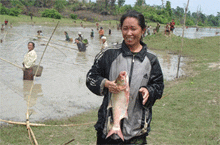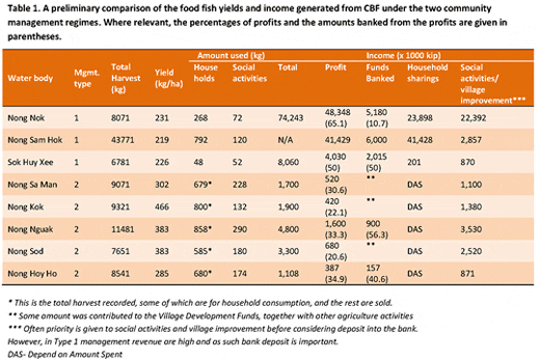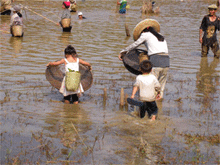Culture-based fisheries (CBF), a practice that utilises small water bodies, for the secondary purpose of increasing the food fish production far in excess of what is potentially achievable through natural recruitment, is gaining momentum in the region. CBF is environmentally friendly, using seed stock as the main external input, and that too of species that are mostly indigenous to the area or sometimes exotics that have been locally used over a long period of time1. It is essentially a stock and re-capture strategy in communal water bodies that are primarily utilised for irrigation of downstream paddy cultivation, where management is through community participation and engagement. The type of water body most suited for CBF is generally small, 3 to 15 ha in size, with a regime that holds water for six to eight months in the year and gradually dries up almost completely. Right; Communal harvesting taking place in Nong Sod village pond, Thongvane village, Paksan district, Borikhamxay province (type two community management)

In Lao PDR, CBF activities in a very minor way have been going on sporadically in a number of areas. With the commencement of a project funded by the Australian Centre for International Agricultural Research (ACIAR) that brought in lessons of successful implementation of CBF practices from countries such as Sri Lanka and Vietnam2,3, CBF development in Lao has reached a new impetus, gaining momentum all the while. As such CBF is increasingly being taken up by village communities to supplement their income and access to food fish on their own accord, but backed up by governmental support in the form training and technology dissemination.
Lao PDR can be considered as an aquaculturally emerging nation meeting its fish needs primarily from wild harvest from the Mekong and other water bodies. Lao PDR is blessed with large fresh water resources (renewable water resource estimated in 2003 to be 333.6 km3; per capita availability as of 2000: 507 m3 year-1 ;https://www.cia.gov/library/publications/the-world-factbook/geos/la.html) that include small flood plain depressions along its river systems, reservoir coves that have become available with the impounding of major rivers and so forth. It is believed that these water bodies are ideally suited for CBF development, and such developments would benefit the communities - mostly farming communities - living in the vicinities of such water bodies, allowing their use as a supplementary livelihood activity using these water resources that were originally for downstream paddy cultivation. Indeed, the Lao government recognises CBF development as a major, low input strategy to increase food fish availability and increasing the livelihoods of rural communities.
The lessons learnt from Sri Lanka and Vietnam, enabled Lao PDR to test the suitability of most productive and appropriate species combinations, stocking densities to be used and other scientific inputs such as fry to fingerling nursing and rearing and so forth3. Table 1. A preliminary comparison of food fish yields and income generated from CBF under the two community management regimes. Where relevant, the percentages of profits and the amounts banked from the profits are given in parentheses.

Community structure and operation
The village communities in Lao are well organised entities and are primarily based on the political system that has evolved in the country over a number of years. Accordingly, the existing village level commune structures were crucial enabling factors in the promotion of the CBF activities. Basically, each village has an elected ‘Head’ and a Community Leader assigned for each of the community activities; for example managing the water regime of the village water source (s) that provides irrigation water mainly for the paddy cultivation. Working with these groups, the initial selection of communities for CBF development activities was carried out, then field visits to work out a management plan based on the characteristics of the water body and development of the most “appropriate CBF package”. More generally, this approach is part of a transition towards more community based fisheries management (CBFM) under evolving governance mechanisms as part of a co-management framework with the government, here mainly the Department of Livestock and Fisheries (DLF) of the Ministry of Agriculture and Forestry.
Co-management comes in many forms but a key question relates to which management functions are most appropriately handled by the community and which by the government. Here most management was handled by the community based on government support. The government support took the form of activities such as dissemination of technical - knowhow and in some instances seed funding for procurement of seed stock and to encourage and train villagers in fry to fingerling rearing in ‘hapas’ when the water regime was at full supply, in order to ensure that the stock when released into the water body is grown to a size that would minimise mortality, primarily from predation. The government monitored the CBF activities with regular visits (once per month) by district extension staff, organised exchanges among CBF communities, and established links with the external partners on a needs basis.
The Lao Government has developed a National Strategy for Fisheries to the Year 2020 including development goals and an action plan from 2006 to 2010. In order to reach its objective, the alleviation of poverty is a crucial factor for which urgent solutions are needed. One of the ways contributing to poverty reduction is by increasing the productive capacity in terms of agriculture, forestry and fisheries and thereby ensuring food security for the poor and also by assisting them to generate more income. As part of this strategy, plans to enact fishery laws were initiated in 2007. As part of this effort the Lao Government, recognising the importance of CBF as a major strategy to increase fish production in rural areas, has included relevant clauses to facilitate rural communities taking up CBF. In essence CBF will soon be legally recognised entities in Lao PDR and will therefore permit communities to engage in such activities with legislative recognition and support.
The main subject of the present paper is to highlight two contrasting revenue sharing CBF practices that are community managed. It is generally rather unusual to see such contrasting practices for revenue sharing, and to the best of our knowledge such practices have not been documented in respect of any aquaculture practice, including CBF.

Revenue sharing from CBF
In Lao PDR, where CBF is still under development, two contrasting revenue sharing practices are encountered, unlike elsewhere in the region. The two forms of revenue sharing practices are:
Type 1 (a more traditional management practice) that is seen mainly in Vientiane Province; here the stocked seed is nurtured (involving the prevention of escape of stocked seed, prevention of unauthorised fishing and poaching, regular repair and maintenance of the outlets etc.) until the fish reaches a marketable size, and then harvested within a short time frame, extending from one to four weeks, depending on the size of the water body. All the revenues are shared within the community on a proportionate ratio to inputs basis. Left; Harvesting in the conventional type of community managed water body (Nong Nok lake, Sivilay village, Vientiane province) Harvesting will take place daily, for three to six weeks
The above revenue sharing is best exemplified by the case of Nongnok Lake, Sivilay Village (see Box 1 for details). It is important to point out that this water body, as for most that have taken up CBF, in the 2008/09 CBF growth cycle, the gross revenue for the community was 74,273,500 Kip (approx: US$ 8,738), and importantly the latter amounted to an increase of 64% over the 2007/08 cycle, based on a corresponding 93% increase in fish yield, with 80% of the harvest completed.
The communal management committee expects to further improve the yield to 12 -14 tonnes in 09/10 cycle, and invest in a weir to partition the water body to maintain its own broodstock, and then it proposes to produce its own seed stocks in two to three years time, and indeed become a seed stock supplier to the surrounding communities. Already the success of this community has been noticed by others and four villages sought their assistance to commence CBF, which is now ongoing.
Type 2 is the practice that is adopted by certain communities particularly in Borikhamxai Province (see Box 2), whereby the community manages the stock, harvest and revenue generation in three stages:
- Stage 1: after a period of growth of the stocked fish seed (usually from June to September), community members are permitted to use hook and line, from shore, to fish for household consumption.
- Stage 2: Small scoop nets (see photos) are permitted from November to December, again to be operated from shore, primarily aimed at harvesting naturally recruited stocks, here again the catches are for household consumption.
- Stage 3: January onwards is the main harvesting season of the stocked species. During this period the community members are permitted to purchase a ticket as a license to fish; this cost of entry into the fishery being determined by the type and size of the gear. For example, to use a standard sized cast net, a ticket costs 10,000 kip (8,500 kip = 1US$) as opposed to a small scoop-net for which a ticket costs 5,000 kip.
All fish caught are the property of the ticket holder and are permitted to be used/ sold in any manner he/she wishes. This process continues for three to four weeks until the water level recedes completely and almost all the stock is harvested. Tickets however, have to be purchased each day as they are valid for only one day. The community gains as harvesting is undertaken by groups/individuals, and the funds raised can be used for community purposes, including funds for procurement of seed stock for the oncoming season, improving community amenities such as the community hall and village temple.

How are the proceeds of CBF shared?
In general, in both of these cases, each community agrees on the manner of sharing the benefits as follows: net CBF income is the income from the fish sales after the deduction for the costs for procurement of fry, any fry to fingerling rearing costs (usually done in hapas), other labour costs of individual households such as for keeping watch of the stocks, and any other investments incurred e.g. purchase of harvesting gear etc. It is also important to note that about 5 to 10% of the harvest is often utilised for common communal functions. On average, these costs amount to about 45% of the total revenue. The community in general, will allocate 10 to 15 % of the revenue for banking, primarily to be used for procurement of seed stock for the following year. Of the rest of the revenue, the community will decide on common investments, such as buying hand-tractors for rice cultivation to be hired on a needs basis, buying land, and for improving social and or communal amenities such as the village temple, communal hall and the like, and the rest is distributed among all stakeholders on an equal household basis and/or based on the proportionate household provision of inputs. Right; Harvesting can be a family activity in water bodies with Type 2 management.
For example, the Sivilay Village Community that practices CBF in Nongnok Lake, in 2008/2009 growth season, divided the proceeds as indicated in Box 1. In the case of the somewhat non-traditional practice, the community management unit will have only the revenue from the ticket sales from fishing for utilisation for communal activities, procurement of seed stock for the following year and so forth.
Why two types of revenue sharing?
The reasons for this difference cannot be easily discerned. One fact is that the average income/standard of living of communities in Borikhamxay Province is generally lower, and the CBF provides a mechanism for the village households to obtain daily food fish needs, for a period of up to six months. There is also a need to earn some extra income when the stocked seed is ready for harvesting / to be marketed and the community decides to permit access. The process adopted, however, limits the overall income that is available for communal activities, and possibly impacts negatively on the financial gains for individual households but increases the possibilities of increasing food fish consumption, even perhaps on a regular basis over a time period, because of the permitted open access to fish for household needs. Further details of this situation and its tradeoffs are being examined in the present culture cycle.
A preliminary comparison of the food fish yields and income generated from CBF under the two community management regimes is summarised in the Table 1. The yields ranged for Type 1 and Type 2 management systems from 219 to 236 and 285 to 466 kg ha-1, respectively. It is difficult to attribute the differences to the type of management per se, on the basis of the presently available data but suffice it to say the yields obtained are generally lower than those obtained elsewhere in the region from CBF practices. This is understandable as CBF practices in Lao are still in their early stages of development. However, indications are that the yields have increased over a two year period in almost all water bodies (see Box 1) and perhaps as time proceeds and the management improves one could expect yields to become comparable to those obtained elsewhere in the region.
Conclusions
The two contrasting revenue sharing practices seen in CBF in Lao PDR both are driven by the community needs and decided upon collectively for the benefit of the community, and not necessarily entirely driven by profit / income generation motives. In the Type 2 case, it is apparent that the poorer communities give a higher priority to food fish needs of its members and as such provide a certain degree of free access to the water body to meet these daily needs, but at the same time ensuring that stock is not overly exploited during the fish growth phase. The regular negotiation of these arrangements by each community within its evolving local context combined with the continuing support/advice of the government provides an effective mechanism to continue to optimise this production system.
It is reiterated that we have chosen to present this preliminary data as we believe that this is the first instance that two distinct forms of benefit sharing are seen in CBF, and for that matter in any form of community managed aquaculture activity. We believe it is interesting and unusual and hence the desire to bring it to the public domain, even though the available data are insufficient to be subjected to robust statistical testing.
September 2009


